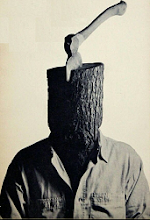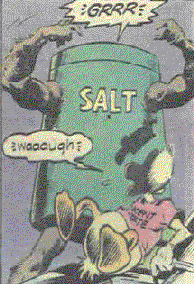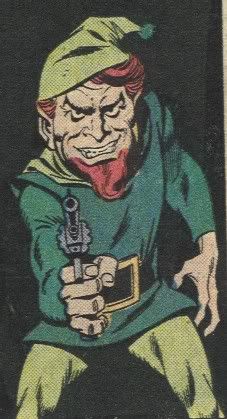An Eleven-Panel Master Course in Comics
Bernard Krigstein was the first and most influential “fine artist” in the comics field. He produced work through the late forties and fifties, leaving behind hundreds of pages of innovative comics. Krigstein pushed harder against the boundaries of the medium than just about anybody, and he developed techniques to exploit its strengths.
Only once in his career was he allowed to lay out a story as he saw fit: an eight-page story in EC Comics’ Impact #1, published in 1955, called “Master Race.” This story is a brilliant example of comics.
A memory-haunted concentration-camp refugee, Carl Reissman, enters a subway car. Shortly, he recognizes a cadaverous stranger who sits across from him. He flashes back to the horrors of the camps until the story reveals that Reissman was in fact the commandant of the death camp. The stranger who recognizes him is a survivor of Reissman’s camp. The stranger chases him down an empty platform. Reissman slips and is crushed by an arriving train. The stranger leaves the station.
Not a great plot, but serviceable. What makes it worth study is how Krigstein told the story.
Here’s the wordless climax of “Master Race.”

Krigstein uses a number of tools specific to comics in this sequence.
The first panel is a well-designed drawing using the strong perspectives one would find in a typical subway station. The two characters and the train, along with the tracks and the receding lines of the ceiling, give a depth to the scene. The flat black of the stranger contrasts with the light figure of the fleeing Reissman, who is flanked on his left by the blackness of the train and tunnel.

Now it gets interesting.
The second panel shifts perspective to below the platform. Reissman’s foot is visible as well as his hat, which now floats above the track. Notice now the lines across the ceiling of the station are gone, as are the shades of gray. What was a detailed scene becomes a more primal image of white and black, with the hint of peril to come: a foot, a hat, and two small “motion lines.” The paper blown in the foreground suggests the rising menace of the train. This transition from detail in panel one to simplicity in panel two draws the reader’s attention on the few elements of importance.

Panels three through six show Reissman’s fall onto the tracks. Aside from the superb draftmanship of the drawings and the sense of reality gained by using such an awkward series of poses, look at the shapes of the panels and the transitions Krigstein uses.

Panel width suggests lengths of time. A wide panel, which takes the eye a few seconds to traverse, usually is meant to depict a longer span than a narrow one, which the reader can absorb in a fraction of a second. The narrowness of these panels therefore imply that each one shows only a short moment of time. The uniformity of the panels suggests that each panel also depicts the same amount of time.
Reissman’s form shows an increasing change in each panel. The transition from panels three to four is much less dramatic than between four and five, or five and six. The man’s fall “speeds up,” reflecting his increasing momentum and the horror of the event.
Breaking the fall up into four panels slows the action down for the reader. Rather than a single panel, the reader must let her eyes travel over the four distinct panels of Reissman’s fall.
Putting these effects together, Krigstein achieves an effect similar to, but different from, cinematic slow motion. An action that the reader can tell took only a second or two, due to the careful depiction of a human body falling, feels as though it took place over a much longer time, due to panel shapes and transitions.
The point of view of these four panels is fixed and distant. Rather than close in on the terror in Reissman’s face or follow the man down to the tracks, the perspective does not shift. This creates an effect of dispassionate observation, rather than identification. The reader maintains a distance from the man, rather than directly sharing in his plight.
Panel seven puts us roughly at Reissman’s point of view. The train is coming, filling the panel. The mechanisms of the train are now visible, and the train is no longer just a black and white abstraction, but a detailed machine in varying shades of black, gray, and white. It’s suddenly become very concrete to the reader.

Panel eight shows Reissman’s fall onto the track, again from a dispassionate perspective and in keeping with the tempo and structure of the previous panels.

Panels seven and eight are the same width and shape as the falling panels, again suggesting brief moments in time. Panel nine grows a bit wider. The reader sees under the train now, where Reissman now lies. Details of the train’s lower front and undercarriage fill the panel.

Reissman shares the panel with the train at last, in panel ten: the last split-second before impact. Again, the panel is narrow. The colors grow more varied, particularly in the background, giving the panel a sense of increased chaos.

Finally comes panel eleven, what Art Spiegelman called a “visual onomatopoeia.”
The stranger watches the train roll past, the faces of the subway passengers dashing by. By employing the Futurist technique of “dynamism,” drawing portions of an image again and again in different places to suggest motion, Krigstein depicts the blur of a rapidly-passing train.* The solid black of the stranger contrasts the motion by its stillness. The width of the panel is greater, showing the reader this is not a fraction of a second, but a longer span.

Beyond the Futurist touch in the repeating faces, panel eleven also has a sly homage to Mondrian. Not wholly relevant to this essay, but cool nevertheless.
Many refer to comics as “movies on paper.” These eleven panels put the lie to such a claim. They can be something else, something unique; a movie could not achieve these effects. Slow-motion photography could not capture the exact effect of panels three through six. A camera could not duplicate panel eleven, with its sophisticated art homages and sense of motion-in-stasis.
The medium is much more than the poor cousin of film.
God, I love comics.
----------------
*Edited to correct terminology, replace the linked picture with a better example, and clean up the wording. For some reason, my brain locked up and couldn't remember the term "dynamism," and the only dynamist painting I could remember was Duchamp's "Nude Descending a Staircase #1," which isn't good for my purposes here. The new link is to a more amusing and less abstract picture.
Only once in his career was he allowed to lay out a story as he saw fit: an eight-page story in EC Comics’ Impact #1, published in 1955, called “Master Race.” This story is a brilliant example of comics.
A memory-haunted concentration-camp refugee, Carl Reissman, enters a subway car. Shortly, he recognizes a cadaverous stranger who sits across from him. He flashes back to the horrors of the camps until the story reveals that Reissman was in fact the commandant of the death camp. The stranger who recognizes him is a survivor of Reissman’s camp. The stranger chases him down an empty platform. Reissman slips and is crushed by an arriving train. The stranger leaves the station.
Not a great plot, but serviceable. What makes it worth study is how Krigstein told the story.
Here’s the wordless climax of “Master Race.”

Krigstein uses a number of tools specific to comics in this sequence.
The first panel is a well-designed drawing using the strong perspectives one would find in a typical subway station. The two characters and the train, along with the tracks and the receding lines of the ceiling, give a depth to the scene. The flat black of the stranger contrasts with the light figure of the fleeing Reissman, who is flanked on his left by the blackness of the train and tunnel.

Now it gets interesting.
The second panel shifts perspective to below the platform. Reissman’s foot is visible as well as his hat, which now floats above the track. Notice now the lines across the ceiling of the station are gone, as are the shades of gray. What was a detailed scene becomes a more primal image of white and black, with the hint of peril to come: a foot, a hat, and two small “motion lines.” The paper blown in the foreground suggests the rising menace of the train. This transition from detail in panel one to simplicity in panel two draws the reader’s attention on the few elements of importance.

Panels three through six show Reissman’s fall onto the tracks. Aside from the superb draftmanship of the drawings and the sense of reality gained by using such an awkward series of poses, look at the shapes of the panels and the transitions Krigstein uses.

Panel width suggests lengths of time. A wide panel, which takes the eye a few seconds to traverse, usually is meant to depict a longer span than a narrow one, which the reader can absorb in a fraction of a second. The narrowness of these panels therefore imply that each one shows only a short moment of time. The uniformity of the panels suggests that each panel also depicts the same amount of time.
Reissman’s form shows an increasing change in each panel. The transition from panels three to four is much less dramatic than between four and five, or five and six. The man’s fall “speeds up,” reflecting his increasing momentum and the horror of the event.
Breaking the fall up into four panels slows the action down for the reader. Rather than a single panel, the reader must let her eyes travel over the four distinct panels of Reissman’s fall.
Putting these effects together, Krigstein achieves an effect similar to, but different from, cinematic slow motion. An action that the reader can tell took only a second or two, due to the careful depiction of a human body falling, feels as though it took place over a much longer time, due to panel shapes and transitions.
The point of view of these four panels is fixed and distant. Rather than close in on the terror in Reissman’s face or follow the man down to the tracks, the perspective does not shift. This creates an effect of dispassionate observation, rather than identification. The reader maintains a distance from the man, rather than directly sharing in his plight.
Panel seven puts us roughly at Reissman’s point of view. The train is coming, filling the panel. The mechanisms of the train are now visible, and the train is no longer just a black and white abstraction, but a detailed machine in varying shades of black, gray, and white. It’s suddenly become very concrete to the reader.

Panel eight shows Reissman’s fall onto the track, again from a dispassionate perspective and in keeping with the tempo and structure of the previous panels.

Panels seven and eight are the same width and shape as the falling panels, again suggesting brief moments in time. Panel nine grows a bit wider. The reader sees under the train now, where Reissman now lies. Details of the train’s lower front and undercarriage fill the panel.

Reissman shares the panel with the train at last, in panel ten: the last split-second before impact. Again, the panel is narrow. The colors grow more varied, particularly in the background, giving the panel a sense of increased chaos.

Finally comes panel eleven, what Art Spiegelman called a “visual onomatopoeia.”
The stranger watches the train roll past, the faces of the subway passengers dashing by. By employing the Futurist technique of “dynamism,” drawing portions of an image again and again in different places to suggest motion, Krigstein depicts the blur of a rapidly-passing train.* The solid black of the stranger contrasts the motion by its stillness. The width of the panel is greater, showing the reader this is not a fraction of a second, but a longer span.

Beyond the Futurist touch in the repeating faces, panel eleven also has a sly homage to Mondrian. Not wholly relevant to this essay, but cool nevertheless.
Many refer to comics as “movies on paper.” These eleven panels put the lie to such a claim. They can be something else, something unique; a movie could not achieve these effects. Slow-motion photography could not capture the exact effect of panels three through six. A camera could not duplicate panel eleven, with its sophisticated art homages and sense of motion-in-stasis.
The medium is much more than the poor cousin of film.
God, I love comics.
----------------
*Edited to correct terminology, replace the linked picture with a better example, and clean up the wording. For some reason, my brain locked up and couldn't remember the term "dynamism," and the only dynamist painting I could remember was Duchamp's "Nude Descending a Staircase #1," which isn't good for my purposes here. The new link is to a more amusing and less abstract picture.





4 Comments:
Good job. Was this in any way a responce to Don Simpson's blog? Not that I have anything against him, his writting is very smart.
Isaac.
By Anonymous, at 1:35 AM
Anonymous, at 1:35 AM
Don Simpson's blog partially inspired this entry, along with the newly-published biography of Krigstein.
Honestly, I agree with Simpson on just about everything. Comics owe a great debt to film, and can continue to learn from movies. We share a distaste for self-consciously arty comics. And we both find the world of comic fandom claustrophobic.
It's mostly a question of emphasis. Simpson stresses the debt comics owe to movies; I stress their uniqueness. We're both right.
By Harvey Jerkwater, at 10:51 AM
Harvey Jerkwater, at 10:51 AM
Normally, analysis makes me less enthusiastic about a work of art; I prefer my own interpretations (which is not to say I know better than a more scholarly, informed type, just that I like to experience things on a more direct level).
This essay did the exact opposite. Thank you!
By Anonymous, at 8:07 AM
Anonymous, at 8:07 AM
Well done, that was excellent.
By David Campbell, at 10:05 AM
David Campbell, at 10:05 AM
Post a Comment
<< Home